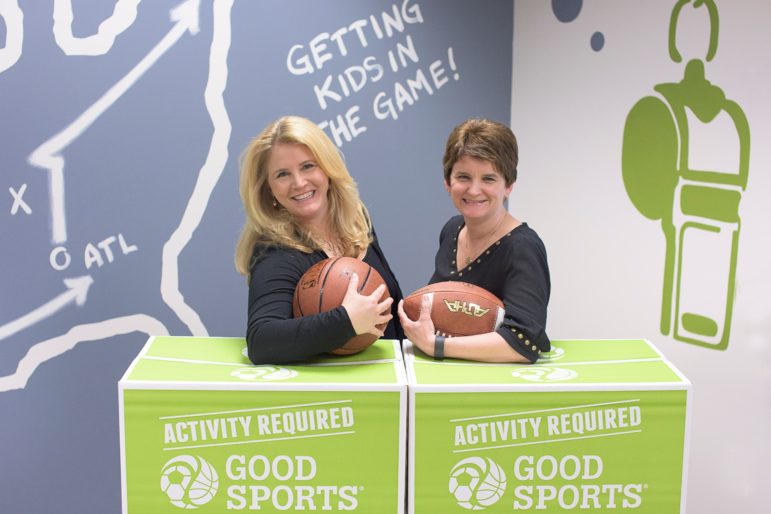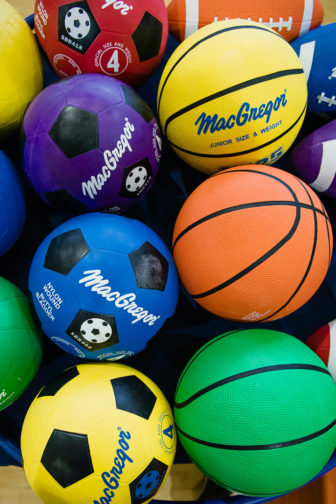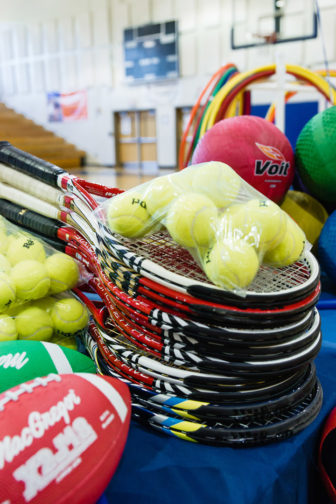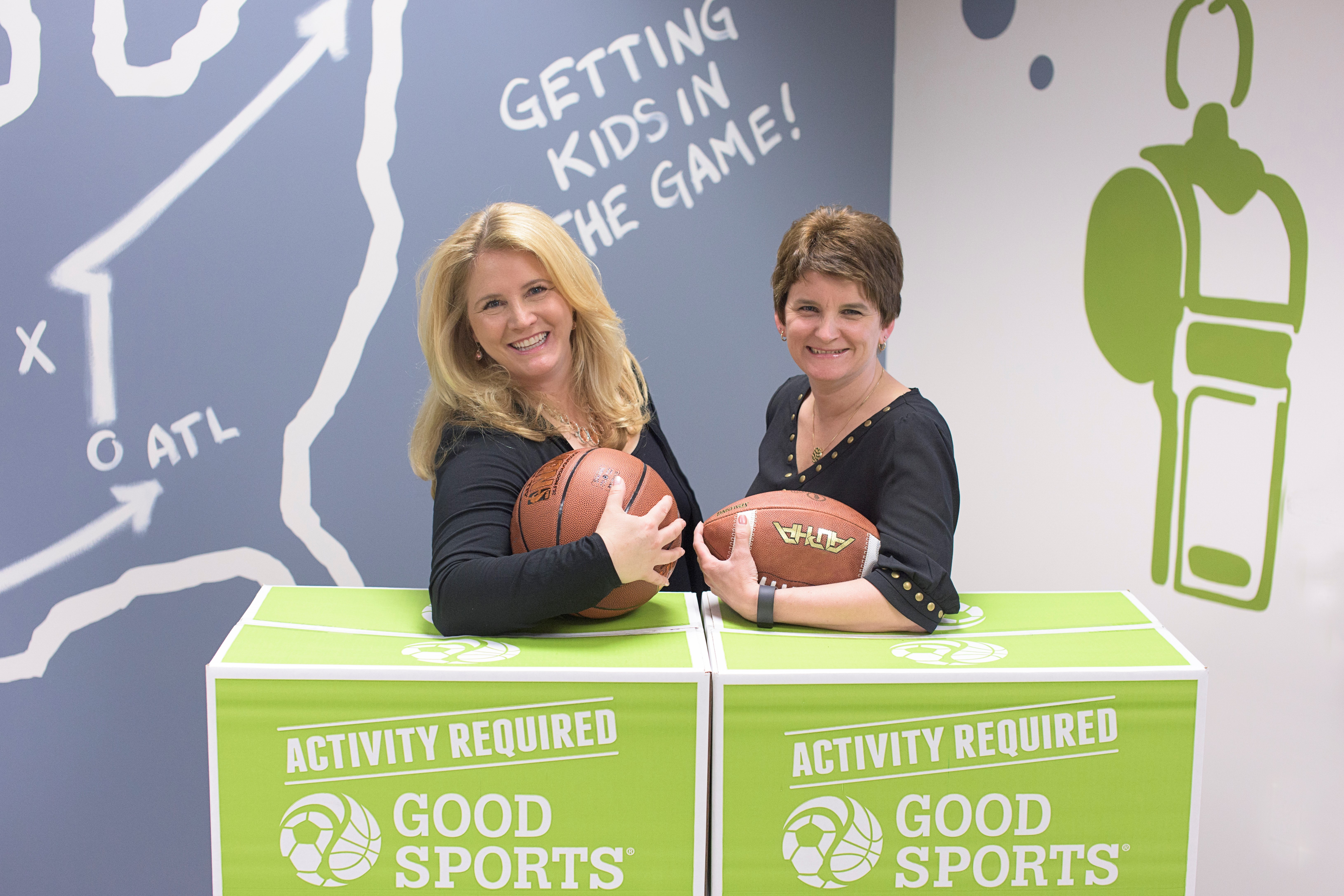
PHOTO COURTESY OF GOOD SPORTS
Christy Keswick (left), COO, and Melissa Harper (right), CEO, represent Good Sports, which has donated more than $16 million in equipment, apparel and footwear, which has impacted 2,200 youth programs nationwide since 2003. “If a girl plays sports and gets involved in physical activity when she is young, as she grows, she has a lot more capacity to try anything, to feel like, ‘If I can do that, I can do these five other things,’ ” says Harper.
The summer custom for high school athletes is to surrender some of their vacation time at the local pool for strength and conditioning workouts to get ready for the upcoming school year. A crowd of devoted athletes in the gym in June and July usually meant one sport: football.
This summer, however, the girls were not on the sidelines in southwest Atlanta. On June 6, a week after the 2015-16 school year ended, athletes at the Coretta Scott King Young Women’s Leadership Academy began their first summer season of workouts.
“This is the first year to utilize our weight room in the summer; it’s pretty exciting,” said Vernise Harris-Hill, the school’s athletic director. “The cheerleaders will be here — and softball, volleyball and basketball players. It is going to really prepare them for the upcoming season.”
Good Sports, a Boston-based nonprofit, partnered with the Atlanta Falcons Youth Foundation to fulfill a grant request for exercise equipment by the King Academy this past spring. The school in southwest Atlanta, which has 200 students, received about $6,000 worth of strength and conditioning equipment and workout apparel.
“This was the missing piece for us,” said Harris-Hill. “This is their space to get better in athletics, but it is also a safe place, a nurturing place.”
And when the school year starts in August, girls like Kiaya Robertson, 16, and Amina Roberts, 16, will continue their workouts. When the school bell rings, they will race up to the second-floor exercise room to use a leg extension/curl machine, a bench press bar with weight plates, and plyometric boxes to improve footwork.
An accessible sanctuary
 Their exercise/work out room is an after-school sanctuary for the girls, a place to exhale, work at their own space, and become one another’s personal trainer without the societal pressure they feel in the daily gym environment.
Their exercise/work out room is an after-school sanctuary for the girls, a place to exhale, work at their own space, and become one another’s personal trainer without the societal pressure they feel in the daily gym environment.
“There is a gym, a local athletic center that is close by here, but the reason our girls don’t go there very much after school is because it is co-ed, and not just for school children, but co-ed for adults,” said Vorise Suggs, the mother of two girls at King Academy: Katlyn, a sophomore, and Sade, a junior.
“The girls just feel safer here with their classmates. They get to work out with them and put in little challenges for each other. They can talk about homework and have camaraderie.”
Harris-Hill’s office has a glass window that looks out into the strength and conditioning room. She is in the building, usually, until 8:30 p.m. and oversees 10 varsity sports.
“They are safe here, we still have our eyes on them, coach is here, we’re a phone call away,” Suggs said. “I know where my girls are. If they finish their workout they can start in on their homework until they are ready to come home.”
Ripple effects
The girls are not only safer, they are healthier and do better academically with a robust after-school physical fitness program.
The National Institute of Out of School Time’s journal “Afterschool Matters,” published findings in 2010 describing how “physical activity, including that accumulated during afterschool programs, can foster cognitive, social, and academic benefits, as well physical benefits such as decreased risk for cardiovascular disease.”
 At Coretta Scott King Academy, the after-school workouts transcend the strength and conditioning room. Kiaya Robertson, who does cross country, volleyball, swimming and soccer, said the workouts have spurred her to adopt better eating habits.
At Coretta Scott King Academy, the after-school workouts transcend the strength and conditioning room. Kiaya Robertson, who does cross country, volleyball, swimming and soccer, said the workouts have spurred her to adopt better eating habits.
Amina Roberts, who runs track and cross country, said her workouts have encouraged her mother to routinely exercise and lose weight.
“For some strange reason coming in here gives me motivation to eat healthier,” Kiaya said, “so I do a gallon of water every day. I stay committed. Being here is motivation.”
Harris-Hill said the donation by Good Sports and the Falcons prompted Atlanta Public Schools to donate even more equipment, which included exercise ropes. “APS saw we were committed to the girls,” the athletic director said.
When various spring sports were in their seasons, Harris-Hill said, the teams filled the weight room. In the last weeks of the 2015-16 school year when varsity seasons were complete, about 10 to 12 girls used the facility routinely on Monday, Wednesday and Friday. On Tuesday and Thursday, they were outside, running.
“When we are on the track, other kids want to work out with us,” said Roberts. “No one is making us do what we do after school. When students see us, they want to do it with us. They come up and say ‘Are you guys going to work out after school today’?”
According to a 2015 study by the Robert Wood Johnson Foundation, 35 percent of boys continue to play sports as adults while only 16 percent of girls continue with some kind of recreational activity.
A boost for girls
The difference in participation between girls and boys is apparent in high school. If there is an after-school basketball game on the gym floor, or YMCA floor, the boys are running the show.
“Just watch an after-school basketball game at school,” said Melissa Harper, the CEO of Good Sports. “A whole lot of boys playing, a whole lot of girls are standing and watching. Every once in awhile there is a girl who will jump in and play with the boys, but it is rather unusual.”
The girls in the King Academy after-school weight room set the agenda, not the boys. Harris-Hill supervises and makes sure the girls are following the proper techniques for safety, but the rest is up to them.
Girls in the U.S. are making gains with participation in high school athletics as opportunities increase. While the participation of boys in high school athletics has dipped, the participation of girls has gone up for the 26th consecutive year in 2014-15 (almost 3.3 million girls participating), according to the National Federation of State High School Associations.
It is important the opportunity is there to close the gap, Harper said.
“If a girl plays sports and gets involved in physical activity when she is young, as she grows, she has a lot more capacity to try anything, to feel like, ‘If I can do that, I can do these five other things’,” Harper said.
“Girls participation from a young age instills a tremendous amount of confidence and self-esteem. It affects the rest of their lives. As they face bigger challenges, they have confidence, and make decisions that are right for them, or for society, or for their peers,” she added.
The after-school ritual of weight training is more than just athletic training and winning. Roberts said her speed has improved with the leg work on the machine, but Harris-Hill looked at Roberts standing next to the bench press and said it is more than performance driving the girls.
“This young lady right here,” Harris-Hill said, pointing to Roberts, “wants to be fit so she can get out of this loose-fitting shirt, so you can see her tone. These workouts build their self-image so they can get out and show what they have been doing.”
Suggs said one of her daughters fell out of a three-mile race before beginning weight training. Now, she competes for the entire three miles.
“This is a place where they can motivate one another, and say things like ‘You can do it, do another rep’,” Suggs said. “It is a very good environment because it can also work out emotional stress. There is more to being here than competing on a team.”






























